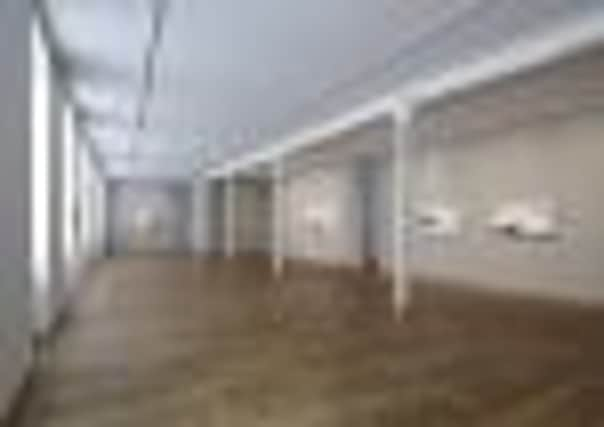Visual art review: Alison Watt: Hiding in Full View


THERE is a photograph by Francesca Woodman titled Depth of Field which shows the artist sitting on the edge of a bed covered with crumpled white sheets. Naked to the waist, she looks at the camera, sad-eyed but defiant.
Rarely does Woodman so directly engage with the viewer. Usually she is half hidden, blending in to the peeling walls and battered wooden cupboards of the semi-derelict Rhode Island houses she loved to work in, the figure melting into its the physical surroundings. In Depth of Field, the two are held briefly, precariously, in balance.
Advertisement
Hide AdAdvertisement
Hide AdThis photograph does not appear in this show, but it has a deep resonance with Alison Watt’s journey. At art school she excelled as a figurative painter and went on to become a portraitist whose subjects included The Queen Mother. She also painted herself “obsessively”. A decade after leaving art school, her work shifted. A rumpled white sheet vacated by a life model brought an epiphany. The fabric evoked the presence and absence of the human more poignantly than the figure.


So the human subject became replaced in her work by folds of fabric, beautifully painted, suggestive, increasingly ambitious in scale. In 2004, she made Still, an immense four-panel painting for the Memorial Chapel at Old St Paul’s Church in Edinburgh, muted, elegiac, resonating deeply with themes of loss and remembrance.
Phantom, the show created in 2008 after two years as artist in residence at the National Gallery in London, revealed another shift. She had begun to paint not from draped fabric in her studio but from imagination. There was a sense of greater freedom and also greater mystery, a more explicit sense of an interior journey.
Last spring, Watt was commissioned by the Uffizi in Florence to make a work for their celebrated collection of self-portraits. She moved her attention from the fabrics of the Old Masters, to Francesca Woodman, a young American who produced a profound and precocious body of photographic work before her suicide in 1981 at the age of just 22. At the Uffizi, her work and Watt’s were shown side by side.
Sadly, neither of these works can be part of the Ingleby show, but the new work here, all produced within the last year, shows the results of Watt’s continuing study of Woodman. It is almost as though a photographic quality has filtered through. In Fount she creates a texture not unlike a black-and-white photograph. Ambit and Rubicon are pair of works showing the same folds of fabric, but each shows slightly different views, as if a camera lens has shifted: some of the lines are crisp, others blurred.
It’s a powerful show. Dove grey walls and muted lighting help to create a sense of silence around the paintings. The works are intense, intimate, they require time, they create hush.
Woodman’s work has an interplay of contradictory impulses. She seems to want to hide and reveal at the same time, to look at herself and avoid her own gaze. She photographed herself obsessively, yet there often is a dreamlike slippage in which her own image becomes elusive. Watt was drawn, she says, to the way Woodman made work that is “difficult to identify and at the same time incredibly intimate”.
Advertisement
Hide AdAdvertisement
Hide AdAnd her paintings are intimate, almost uncomfortably so. They are details, close-ups, unflinching. The eye is drawn to the dark openings, the voids between the folds, yet I find myself reluctant to look too deeply for fear of what I might find. While working at the National Gallery, Watt found herself drawn to the shadows and voids, the open mouth of Zurbaran’s St Francis; the shadow under the arm of Ingres’ Mme Moitessier; and Courbet’s L’Origine du monde. In these new paintings, the smooth fabric folds look more than ever like the folds of the human body. There are depths here – physical, sexual, psychological, emotional.
They may or may not be self portraits, Watt isn’t saying. Either way, they are depictions of an interior landscape which probes the things we keep secret, even from ourselves. Woodman, too, did this.
In a photograph called My House, Providence, Rhode Island Woodman shows herself in the corner of a room, naked and wrapped in cellophane. The light hits the plastic obscuring her face, but we can just make out her body. It’s easy to see her as half-ghost, prefiguring her early death. Yet that seems too easy. Perhaps it is more about how hard it is to really look at ourselves, the way an inanimate object can become a stand-in, a more effective, more resonant “portrait”.
Woodman made self portraits obsessively, while continually questioning whether a self portrait was really possible. For how can we ever really see ourselves, given how accomplished we are at evasion? Perhaps Watt’s paintings engage with something similar, with the voids and secrets within the human heart. If they make for disturbing viewing it is perhaps they remind us that we, too, have such voids within ourselves.
Alison Watt: Hiding in Full View
Ingleby Gallery, Edinburgh
****
• Until 28 January